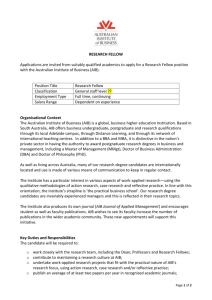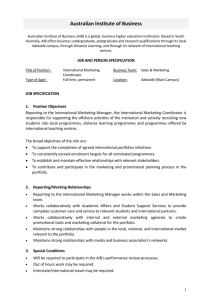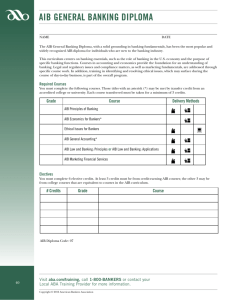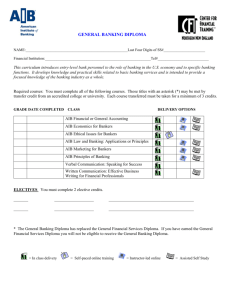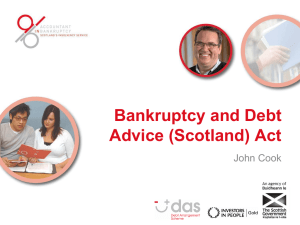Third Party Copyright
advertisement
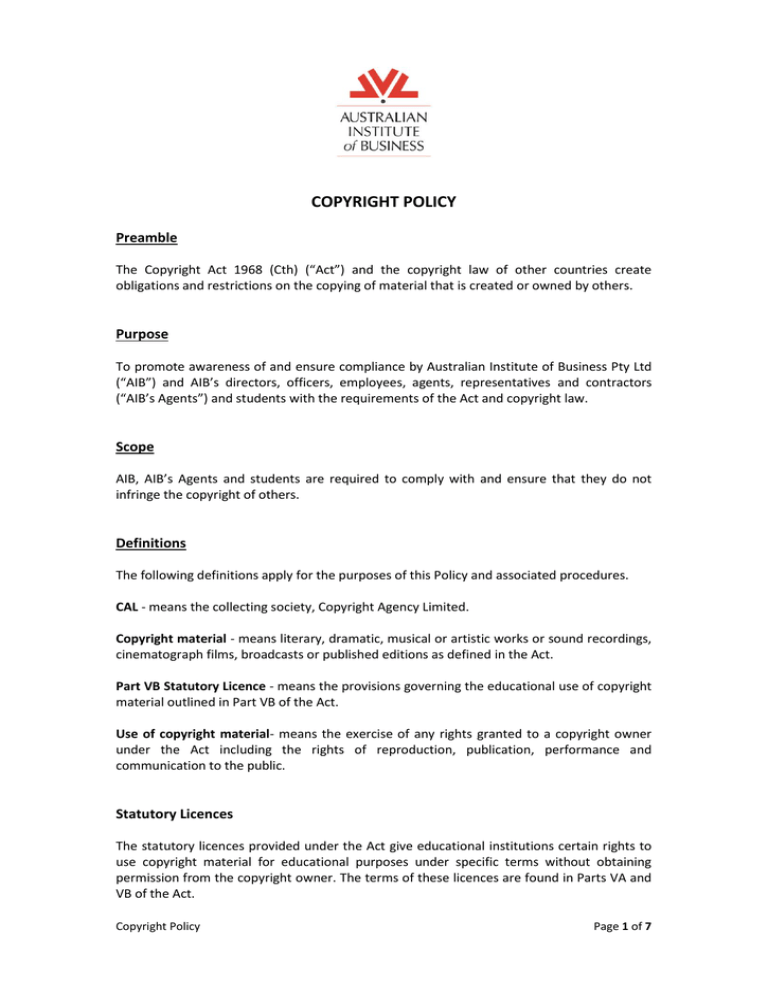
COPYRIGHT POLICY Preamble The Copyright Act 1968 (Cth) (“Act”) and the copyright law of other countries create obligations and restrictions on the copying of material that is created or owned by others. Purpose To promote awareness of and ensure compliance by Australian Institute of Business Pty Ltd (“AIB”) and AIB’s directors, officers, employees, agents, representatives and contractors (“AIB’s Agents”) and students with the requirements of the Act and copyright law. Scope AIB, AIB’s Agents and students are required to comply with and ensure that they do not infringe the copyright of others. Definitions The following definitions apply for the purposes of this Policy and associated procedures. CAL - means the collecting society, Copyright Agency Limited. Copyright material - means literary, dramatic, musical or artistic works or sound recordings, cinematograph films, broadcasts or published editions as defined in the Act. Part VB Statutory Licence - means the provisions governing the educational use of copyright material outlined in Part VB of the Act. Use of copyright material- means the exercise of any rights granted to a copyright owner under the Act including the rights of reproduction, publication, performance and communication to the public. Statutory Licences The statutory licences provided under the Act give educational institutions certain rights to use copyright material for educational purposes under specific terms without obtaining permission from the copyright owner. The terms of these licences are found in Parts VA and VB of the Act. Copyright Policy Page 1 of 7 AIB has entered into an agreement with CAL for access to a Part VB Statutory Licence for a fee. AIB does not have a Part VA statutory licence under Part VA of the Act, which would cover copying and communication of broadcasts, e.g. television and radio broadcasts. What can be copied? Under Part VB of the Act (which covers print and graphic copying and communication), only a ‘reasonable portion’ of a copyright work can be copied or communicated (the ‘reasonable portion’ limits are outlined on CAL’s website (see “FAQ’s for Educational Licence Holders”) and this must be for educational purposes. For example, the Part VB Statutory Licence does not apply to AIB’s or AIBs Agents’ marketing materials, because marketing is not an ‘educational purpose’. It also does not cover the copying and distribution of articles, such as in newspapers or other press about AIB. What can be communicated? Online communication of copyright material is allowed under the Part VB Statutory Licence, subject to ‘reasonable portion’ limits on the amounts that may be copied. AIB’s Agents who wish to make copyright material available via the AIB website must: (a) ensure it is for educational purposes; and (b) ensure that the amounts of an item of copyright material does not exceed limits on the amounts that may be copied; and (c) ensure that a copyright warning notice (see below) appears with the material and that appropriate source information is recorded; or (d) obtain the prior written permission from the copyright owner for the proposed use and retain this for the full period the material is available online. Copyright warning notice A warning notice must be attached to digital copies of any material copied or communicated under the Part VB Statutory Licence. The wording of the notice is prescribed by the Regulations (copy attached at Annexure 1) and may not be changed. The size and position of a notice is not specified, but it must appear on the screen before or at the same time as the copied material. It is not acceptable to offer the notice as a click through link that gives the viewer the option to bypass it. The notice should be used only with material copied in reliance of the Part VB Statutory Licence. The notice should not be used with material copied with permission of the copyright owner or under any other blanket licence. AIB and AIB’s Agents must take all reasonable steps to ensure that each communication can only be received or accessed by people entitled to receive or access it (this would normally mean staff and students of AIB). Appropriate warning notices MUST be placed in the following locations or on all items and media files as required under the Act: Copyright Policy Page 2 of 7 (a) (b) (c) (d) Hard copy warning notices must be displayed beside any machines which are capable of allowing copying or communication of copyright material by students, e.g. photocopiers, computers, video cameras, scanners and other electronic data storage devices. Photocopies made under Part VB must have a copyright notice attached (see Annexure 1). Video copies of broadcasts made under Part VA must have the required label affixed as required by the Act (please note that AIB does not have a Part VA statutory licence). The required electronic copyright warning notice must appear at the beginning of digital copies of material communicated under Part VA or VB (or other sections of the Act if required). Copying of audio-visual material AIB, AIB’s Agents and students must not copy and communicate television or radio broadcasts under Part VA of the Act as AIB does not have a Part VA statutory licence. Moving image material available on commercial film or video or the Internet must not be copied without the permission of the copyright owner. Please note that the Part VB Statutory Licence does not cover the copying of video content (e.g. from YouTube or otherwise). Hyperlinks AIB may use hyperlinks in its educational materials (e.g. AIB’s Learning Management System) to external websites that contain words and images in most cases without seeking the copyright owner’s permission, but if it is required, such words and images should be covered by the Part VB Statutory Licence. Evenso, the following issues need to be considered on a case by case basis for each item of content on external websites: (a) prior permission to link to an external website may be required under the terms and conditions for the use of the external website. (b) whether the existence of the item of content on an external website infringes (or is likely to infringe) the owner of the intellectual property rights in that item of content, e.g. if the content was a copy of a 20th Century Fox labelled movie, it is highly likely that it will infringe copyright and trademark laws. (c) where it is unclear and the content is likely to infringe copyright, please review the content and see if the uploader has licensed or has rights to use it in a way that allows commercial or educational use without permission (e.g. a creative commons licensed video, such as those on Creative Commons Search ). (d) If no licence or rights have been given, AIB’s Agents should seek to obtain permission to use the content from the copyright owner, who may not be the uploader, or obtain a licence to use the material from a pay for use service. Permission from the Copyright Owner If permission is obtained from the copyright owner, material can be used in the manner authorised by that permission without any further reference to copyright restrictions. Copyright Policy Page 3 of 7 A draft permission letter for staff who wish to approach copyright owners to request permission to use material is at Annexure 2. Permissions Register Any of AIB’s Agents who obtain permission for the use of copyright material must maintain appropriate files recording details of permissions obtained for the full period of the use and notify the Chief Information Officer, who will maintain a register of such permissions. Copyright in computer software Computer software is protected as a literary work under the Act. AIB provides access for AIB’s Agents to computer software through commercial licence agreements. These licences are managed by the Chief Information Officer. Illegal File Sharing AIB, AIB’s Agents and students will not allow material which infringes the rights of copyright owners to be stored, transmitted or made available on any part of AIB’s network. This includes infringing material transferred via peer-to-peer networks and material illegally copied from other media. Moral Rights Part IX of the Act provides for the moral rights of the creators of literary, dramatic, musical or artistic works and cinematograph films. Moral rights attach to individuals only. The two moral rights which apply within Australia are the right to be acknowledged as author (attribution), unless it is reasonable not to (or the author has consented to not being attributed) and the right for a work to be treated as a whole (integrity). AIB respects the moral rights of all authors of copyright material as well as those of its staff and students. AIB and AIB’s Agents and students must avoid making changes or additions to images (and other works) that are unreasonably ‘derogatory’ (prejudicial to the creator). Responsibility Joint CEO Operations. Related Policies: Commercialisation of Intellectual Property Created by Staff and Students Current Status Approved By: Date of Approval: Previous version: Copyright Policy Version 1 Board of Directors 24 May 2016 Third Party Copyright (Version 2) 1 July 2011 Page 4 of 7 Annexure 1 (Copyright Warning Notice- Electronic Use) COMMONWEALTH OF AUSTRALIA Copyright Regulations 1969 WARNING This material has been reproduced and communicated to you by or on behalf of Australian Institute of Business Pty Ltd pursuant to Part VB of the Copyright Act 1968 (the Act). The material in this communication may be subject to copyright under the Act. Any further reproduction or communication of this material by you may be the subject of copyright protection under the Act. Do not remove this notice. Copyright Policy Page 5 of 7 Annexure 2 (Draft Letter to copyright owner) [AIB’s letterhead] [insert date] [insert name] [insert title] [insert address details] Dear [insert name] Request for permission to use [Material From] [Insert Title] I am writing on behalf of the Australian Institute of Business Pty Ltd (“AIB”). AIB wishes to use the following material of which you are the [author/publisher]: [insert details of material sought to be used – type (eg article, quote (cite in full), art work, logos, diagrams, graphs, tables, music etc) author/composer, date of publication, title, publication, page, section and/or paragraph/s] We propose to: [remove any of the following that do not apply] 1. 2. 3. 4. reproduce the material in [hardcopy form/digital form]; communicate the material [on an intranet / on the Internet / by email]; publish the material [insert a description of where the material will be published] [insert a description of any other required uses] AIB seeks your permission to use the above mentioned material in this way. The purpose of the use would be to [insert description of purpose of proposed use e.g. prepare a learning resources to be distributed to AIB’s students]. If you do not control the copyright in all of the above mentioned material, I would appreciate any contact information you can give me regarding the proper rights holder(s). Otherwise, your permission confirms that you hold the right to grant the permission requested here. If you require any additional information, please contact me on [insert] or by email on [ insert]. If you agree with the terms as described above, please sign the permission form below and send one copy in the self-addressed return envelope I have provided. A duplicate copy of this permission form is enclosed for your records. Yours sincerely [signature] [insert name] [insert position] Copyright Policy Page 6 of 7 Permission granted for the use of the material as described above: Name:……………………………………………… Title: ……………………………………………... Company/ Organisation: ……………………………………….. Signature: ……………………………………………………….. Date: ……………………………………………………………… Letter preparation notes (to be deleted from final version of letters): 1. This letter should be used when there is no existing licence which permits the proposed use of the material. 2. Replace the italicised text with relevant details, and ensure that all italicised text is replaced or deleted before sending. 3. Send the signed original of this letter, plus a duplicate copy, to the addressee. 4. Do not use the material until an affirmative response is received. Copyright Policy Page 7 of 7

